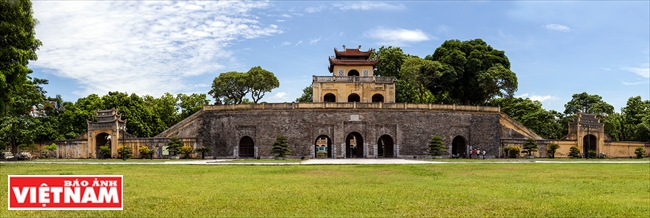After moving to Thang Long, Ly Cong Uan built several palaces, including Kien Nguyen for holding court, Tap Hien and Giang Vu located by the two sides of Kien Nguyen, Long An and Long Thuy for the king to rest, and Thuy Hoa for imperial maidens.
|
The woodblock recording the renovation of Dai La citadel in 808. The woodblock of King Ly Thai To’s relocation of the capital in 1010. Photo: Cong Dat / VNP Recording King Ly Thai To’s construction of palaces in Thang Long citadel in 1010. The content on King Ly Cong Uan’s upgrading of Thang Long citade in in 1024. About King Ly Thanh Tong’s construction of Bao Thien tower in 1057.. The woodblock on King Tran Thai Tong’s building of palaces in Thang Long citadel in1230. About King Tran Thai Tong’s construction of Long Phuong citadel in 1243. The woodblock which records King Le Thai To’s renaming of Dong Do as Dong Kinh in 1430. Photo: Cong Dat / VNP Beautifully carved characters. On King Le Thanh Tong’s renovation of Kinh Thien Temple in 1465. On King Gia Long’s naming of Thang Long (flying dragon) citadel in 1805. On King Minh Menh’s building of Tinh Bac tower in 1821. |
In 1057, King Ly Thanh Tong built Bao Thien Tower, also called Dai Thang Tu Nhien. The building of this 12-story tower was recorded in the woodblocks of the Complete Annals of Dai Viet.
The woodblocks also noted King Tran Thai Tong’s expansion of Dai La citadel in 1230 and the upgrading of Quoc Tu Giam (Imperial Academy) in 1243.
The renaming of Thang Long as Dong Do was written in the woodblocks of the Imperially Ordered Annotated Text Completely Reflecting the History of the Viet, also recorded the building of Van Tho, Kinh Thien and Can Chinh Palaces by King Le Thai To in 1428.
 The Imperial Citadel of Thang Long, a world cultural heritage. |
In 1819, King Gia Long mobilized 5,300 soldiers for the renovation of Thang Long Citadel, which was written in the woodblocks of the Annals of Dai Nam (the main part)./.
| The woodblocks of the Nguyen dynasty were created during the operation of the National Historian Office of the Nguyen Dynasty. The woodblocks consist of 34,618 plates carved with Han Chinese scripts and Vietnamese Nom ideographic scripts to print books and documents in Vietnam in the 19th century and early 20th century. The content of the woodblocks reflects the establishment and development of the country through history, literature, militarization and legislation. The woodblocks of the Nguyen Dynasty were recognized as a World Documentary Heritage by UNESCO in 2009. |
By Cong Dat



